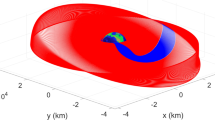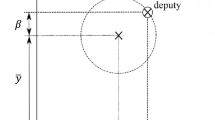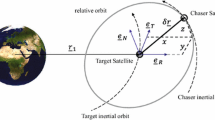Abstract
Control strategies to maintain spacecraft formation flying and constellation station keeping orbits are presented in this paper. For small or nanosatellites, the potential control thruster used in orbital control could be of the low-thrust type. The control methods that can adapt to different thrust levels without compromising the system performance and the mission task are investigated. Autonomous algorithms (analytic solutions that can be easily executed in real-time) that can be easily implemented on board are considered at the same time to reduce the overall cost of the mission.
Similar content being viewed by others
References
BAINUM, P. M and DUAN, X. DOD-DARPA Technical Report 002AC-R&D, Howard University, Washington, DC, October 1, 2001–December 30, 2001.
DUAN, X. and BAINUM, P. M. “Design of Spacecraft Formation Flying Orbits,” presented as paper AAS 03-588 at the AAS/AIAA Astrodynamics Specialist Conference, Big Sky, MT, August 3–7, 2003.
DUAN, X. and BAINUM, P. M. “Formation Flying and Constellation Station Keeping in Near-Circular Orbits,” presented as paper AAS 04-304 at the 14th AAS/AIAA Space Flight Mechanics Meeting, Maui, Hawaii, February 8–12, 2004; also appeared in Actual Problems of Aviation and Aerospace Systems, 1(17), Vol. 9, 2004, pp. 32–49.
HASHIDA, Y. and PALMER, P. L. “Epicyclic Motion of Satellite About an Oblate Planet,” Journal of Guidance, Control, and Dynamics, Vol. 24, No. 3, May–June 2001, pp. 586–596.
BROUCKE, R. A. “Solution of the Elliptic Rendezvous Problem with the Time as Independent Variable,” Journal of Guidance, Control, and Dynamics, Vol. 26, No. 4, July–August 2003, pp. 615–621.
SCHWEIGHART, S. A. and SEDWICK, R. J. “High-Fidelity Linearized J2 Model for Satellite Formation Flight,” Journal of Guidance, Control, and Dynamics, Vol. 25, No. 6, November–December 2002, pp. 1073–1080.
YEH, H.-H., NELSON, E., and SPARKS, A. “Nonlinear Tracking Control for Satellite Formations,” Journal of Guidance, Control, and Dynamics, Vol. 25, No. 2, 2002, pp. 376–386.
CLOHESSY, W. H. and WILTSHIRE, R. S. “Terminal Guidance System for Satellite Rendezvous,” Journal of the Aerospace Sciences, Vol. 27, No. 9, 1960, pp. 653–658, 674.
TSCHAUNER, J. and HEMPEL, P. “Rendezvous zu einem in elliptischer Bahn umlaufenden Ziel,” Astronautica Acta, Vol. 11, No. 2, 1965, pp. 104–109.
CARTER, T. E. “State Transition Matrices for Terminal Rendezvous Studies: Brief Survey and New Example,” Journal of Guidance, Control, and Dynamics, Vol. 21, No. 1, Jan.–Feb., 1998, pp. 148–155.
KAUTSKY, N. and DOOREN, V. “Robust Pole Assignment in Linear State Feedback,” International Journal of Control, Vol. 41, No. 5, 1985, pp. 1129–1155.
KWAKERNAAK, H. “Asymptotic Root Loci of Multivariable Linear Optimal Regulators,” IEEE Transactions of Automatic Control, Vol. AC-21, 1976, pp. 378–382.
Author information
Authors and Affiliations
Corresponding author
Rights and permissions
About this article
Cite this article
Duan, X., Bainum, P.M. Low-Thrust Autonomous Control for Maintaining Formation and Constellation Orbits. J of Astronaut Sci 53, 65–82 (2005). https://doi.org/10.1007/BF03546395
Published:
Issue Date:
DOI: https://doi.org/10.1007/BF03546395




